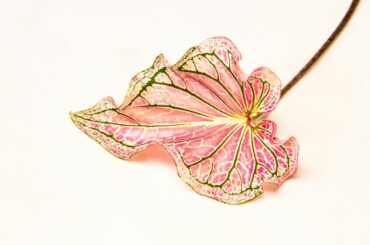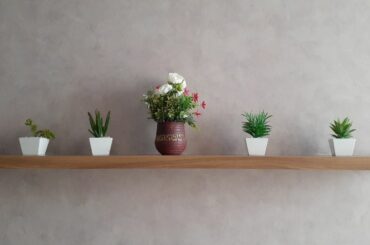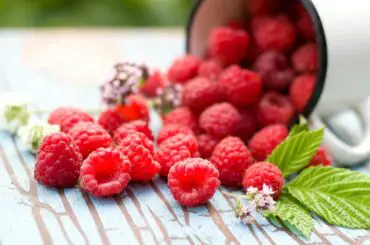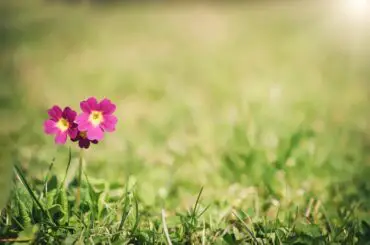With their vibrant, exotic blooms and huge, glossy leaves, both the bird of paradise and banana plant evoke images of tropical paradise. Though they hail from different parts of the world, these two plants have more in common than you might expect. But they also have key differences that make each one unique.
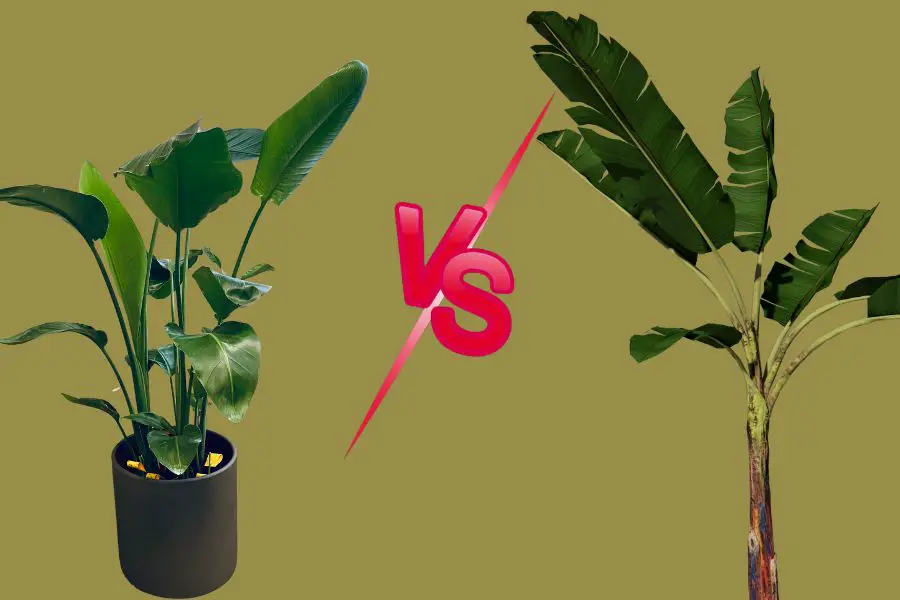
Let’s take a closer look at Bird of Paradise vs Banana Plant and see how they stack up against each other.
Origin Stories: Worlds Apart
Contents
The bird of paradise is native to South Africa, where it thrives in warm, frost-free climates. Its name comes from its fantastical, bird-like flowers that look like they belong in a Dr. Seuss book.
Meanwhile, the banana plant traces its roots to humid tropical regions of Southeast Asia and Australia. Originally growing wild, bananas were cultivated as an early crop in Papua New Guinea.
So while the bird of paradise calls South Africa home, the banana plant originated on the opposite side of the globe.
Growing Conditions: Similar Needs
Despite their far-flung backgrounds, the bird of paradise and banana plant have comparable growing requirements.
Both plants thrive in warm, humid environments with temperatures between 70-80°F. They also enjoy bright, indirect light inside. Direct hot sunlight can scorch their leaves.
Rich, well-draining soil is ideal for both the bird of paradise and banana. Dense clay or soggy soil will cause root rot. Adding compost improves drainage.
One difference is that banana plants need more water than bird of paradise. Allow the top few inches of soil to dry between waterings for a bird of paradise. Banana plants prefer consistently moist (but not soggy) soil.
When it comes to feeding, use a balanced liquid fertilizer for both plants during the growing season. This fuels flowering and healthy growth.
Flower Power: Blooms That Wow
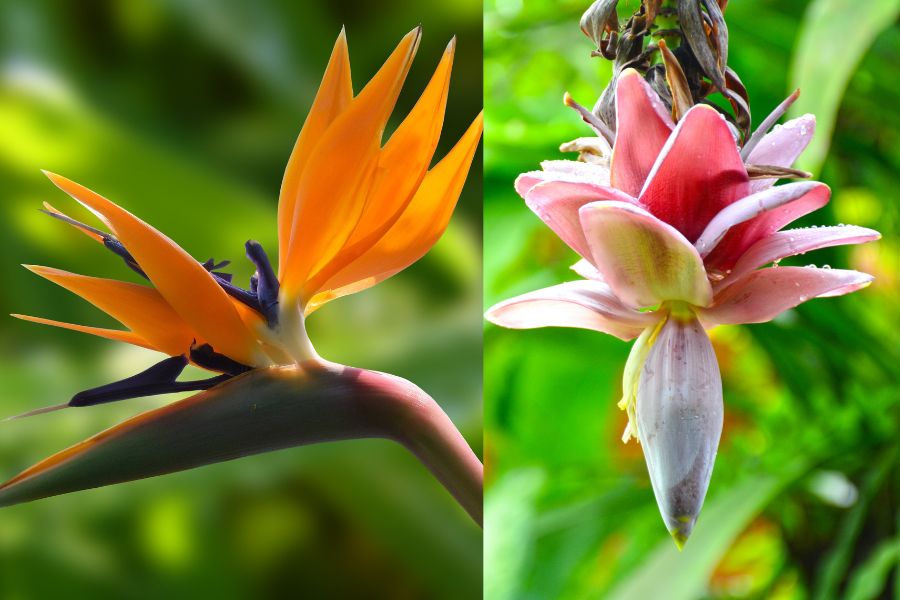
Now let’s talk flowers—because both the bird of paradise and banana plant produce showy blooms, albeit very different ones.
The bird of paradise’s vivid orange and blue flower spathes are unmistakable. Resembling tropical birds in flight, they can grow over 6 inches long. Flowers take years to appear on young plants. But once mature, a bird of paradise may bloom year-round in optimal conditions.
Bananas sprout hanging clusters of white flowers which become…you guessed it…bananas! Rows of flowers bloom at the end of elongated stems, maturing into fruits packed together in “hands”. Each banana flower only blooms once before dying. But new flowers continually emerge and form fruit.
So the bird of paradise dazzles with its flashy, long-lasting blooms, while the humble banana produces more subtle flowers and large fruit clusters.
Foliage Features: The Big and Small of It
When not in flower, both plants make a dramatic statement with their leaves—though the banana’s leaves are much, much larger.
The bird of paradise unfurls bold, paddle-shaped leaves up to 18 inches long. New leaves emerge from a central cylinder, forming a fan. The leaves may be solid green or variegated with streaks of white, pink, or red.
Meanwhile, the banana plant has huge, wide leaves that can grow over 9 feet long and 2 feet wide. These supple leaves unfurl from the center, extending outward in a spiral formation as new ones emerge. The leaves are generally solid green on the top and silvery underneath.
So the bird of paradise has impressively sizable leaves—but the banana plant takes things to another level with truly enormous foliage.
Size and Growth: A Case of the Jumbos
Speaking of size, banana plants also outpace bird of paradise in terms of sheer mass and growth rate.
Bird of paradise typically reaches 3-4 feet indoors. Outdoors in ideal conditions, it may eventually hit 6-8 feet tall. However, it maintains a relatively compact shape.
The banana plant has a rapid growth rate, quickly surpassing the bird of paradise. Indoors, banana plants may reach 6-8 feet. In the ground outside, they can rocket up to 20-25 feet tall! Bananas also produce suckers, multiplying into large clumps.
If you’re looking for a fast-growing plant that makes a big statement, you can’t go wrong with a banana. The bird of paradise offers a more refined, sculptural look.
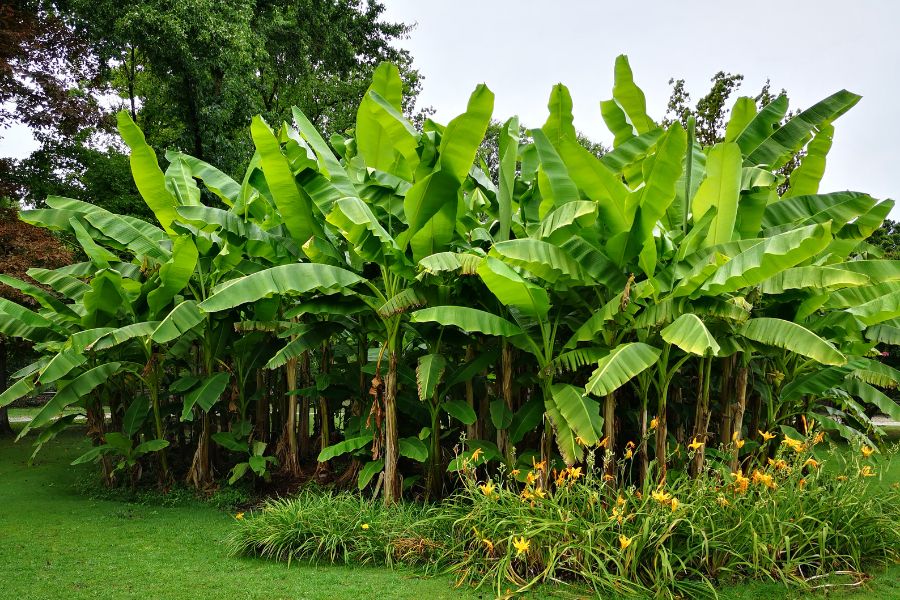
Care Difficulties: Pretty Easygoing
Luckily, both the bird of paradise and banana plant are fairly simple to care for despite their exotic look.
Bird of paradise plants have some sensitivity to tap water, so filtered or distilled water is best. Allow soil to partially dry out before watering. Dusting leaves regularly and providing good air circulation prevents fungal disease.
For bananas, the most common woe is brown leaf tips caused by dry air or irregular watering. Otherwise, banana plants are very forgiving! Just be sure to provide plenty of space and heavy support once they grow large.
When cared for properly, both plants are remarkably vigorous. Don’t let their tropical beauty intimidate you!
Takeaways: Key Similarities and Differences
To recap, here are the major points of alignment and contrast between these two tropical showstoppers:
- Similarities: Both hail from the tropics, require warm temps, moist soil, and bright light. Neither handles frost. Also, both have relatively easy care when their needs are met.
- Differences: Bird of paradise originates in Africa, banana plant in Asia/Australia. Bananas grow much larger and faster. Bananas produce edible fruit, while bird of paradise offers stunning blooms. Bird of paradise has finer, paddle-shaped leaves while banana leaves are huge.
No matter which one you choose, you really can’t go wrong! The bird of paradise and banana plant both bring a taste of the tropics indoors. With a little TLC, these exotic beauties will flourish.
So there you have it—a blow-by-blow comparison of two of the most spectacular plants you can grow inside. Whether you’re swayed by the banana’s fast and lush growth or the bird of paradise’s striking blooms, these tropical plants are sure to bring big visual impact with minimal fuss. Bring on the jungle vibes!
Read Next: Caladium Dying : The Complete Guide to Prevention

